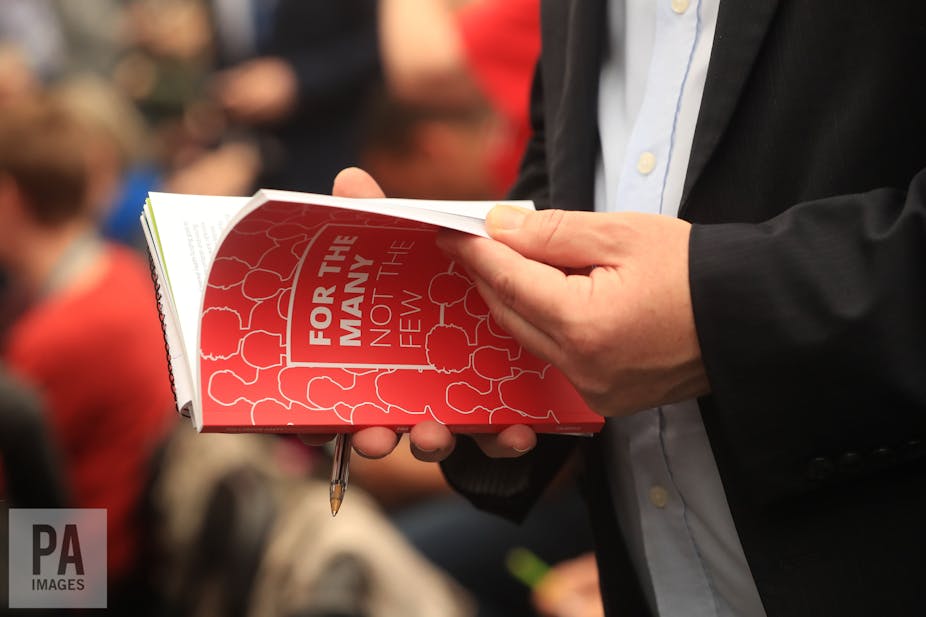The Labour Party’s manifesto has bold proposals for raising expenditure on key items, together with costings detailing how it claims it will be able to finance this through raising almost £50 billion in extra taxes.
Areas earmarked for higher spending include education. More will be spent on schools and the Sure Start support services for parents of young children. The maintenance allowance for university students would be reintroduced and university tuition fees abolished. Health and social care will also receive extra funding. And Labour promises to restore some benefit cuts and end the public sector pay freeze.
Labour has also proposed a National Transformation Fund, with £250 billion for public investment. But this is not matched to higher taxes on the principle that infrastructure spending is investment and it is therefore legitimate to borrow to finance this on the assumption that it will pay off in the future.

The extra commitments are costed at £48.6 billion and the key issue is whether or not Labour can raise the tax funds to pay for them. Labour has committed to not raising National Insurance, VAT or income tax for 95% of the workforce. The majority of the extra taxation would be raised from increasing corporation tax and income tax on the highest earners.
Taxing the wealthiest
The largest single item, accounting for around 40% of the increased tax take, comes from raising the corporation tax rate from 20% to 26% over the next parliament. Further revenues are to be raised from lowering the threshold for the 45% tax band to those earning over £80,000 and reintroducing the 50% top rate for incomes above £123,000. Taxes would also be raised through various measures including an excess pay levy and a “Robin Hood tax” on trading derivatives and other financial products. Overall, this major increase in public expenditure would be funded by tax rises on the wealthiest.
The projected changes in tax rates may appear relatively modest; the corporate tax rate would remain low by developed country standards and would still be below levels in 2010. Nevertheless, the projected rise in tax take is large – in particular, receipts from corporation tax would almost double over the lifetime of the next parliament.
The questions here are how far it is plausible to raise these revenues from groups that are best placed to avoid them through various means. The manifesto makes some allowance for slippage here, allowing an offset of £3.7 billion to reflect uncertainties and potential behavioural change. On the other hand, the costings also project a further £6.5 billion to be raised from an ambitious programme to tackle tax avoidance and evasion (this is roughly the same amount projected to be raised from high top rate income taxes).
Major uncertainties
There are major uncertainties over whether these tax hikes would be able to raise the projected sums – the Institute for Fiscal Studies has indicated that it is possible, but revenues could also fall a long way short. In part, this reflects uncertainty over possible tax avoidance. More widely, it would also depend on the growth of these incomes.
The top 1% of taxpayers already accounts for over a quarter of income tax receipts, partly reflecting their relatively strong income growth. Corporate tax receipts have grown strongly in recent years with profit growth, although their share of total tax receipts remains below levels seen before the 2007-08 financial crisis.

Perhaps the biggest uncertainty with corporate tax rate rises would be the response of companies. If they were to respond by cutting investment this would lower growth; they may also respond to lower post-tax profits by trying to squeeze wage costs in compensation.
This is the broader point; whether expenditure plans can be fully financed depends not just on the tax and expenditure decisions of politicians, but crucially on how the economy develops. The British economy faces major uncertainties, not least from Brexit. The Labour manifesto costings don’t directly address this; elsewhere, the manifesto aims to retain the benefits of the single market but of course this depends on negotiations with the EU.
Any British government trying to deliver quality public services without borrowing further will have to look at tax rises. And the Conservatives have already indicated that they are shifting away from earlier promises not to raise key taxes. Meanwhile, successive governments have missed their deficit targets.
A number of commentators have noted that Labour’s proposals did not include costings for re-nationalising railway companies and water utilities, but this is based on a misunderstanding. In the first place, the proposal is not to take these companies back into public ownership on day one of a Labour government – with the rail companies, for example, it would only take place when the existing franchises come to an end. More fundamentally, this would not be current expenditure. The state would be acquiring an asset which would be expected to yield returns in the future. Government bonds would be issued for this, but it can be seen as a future investment.
So overall, Labour’s tax and spending plans are not as radical as they have been presented. They do, however, depend a great deal on forces outside of the government’s control. Any British government trying to maintain or improve public services would face hard choices for raising taxes if borrowing is not to rise further.

